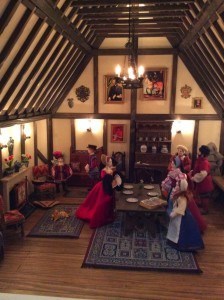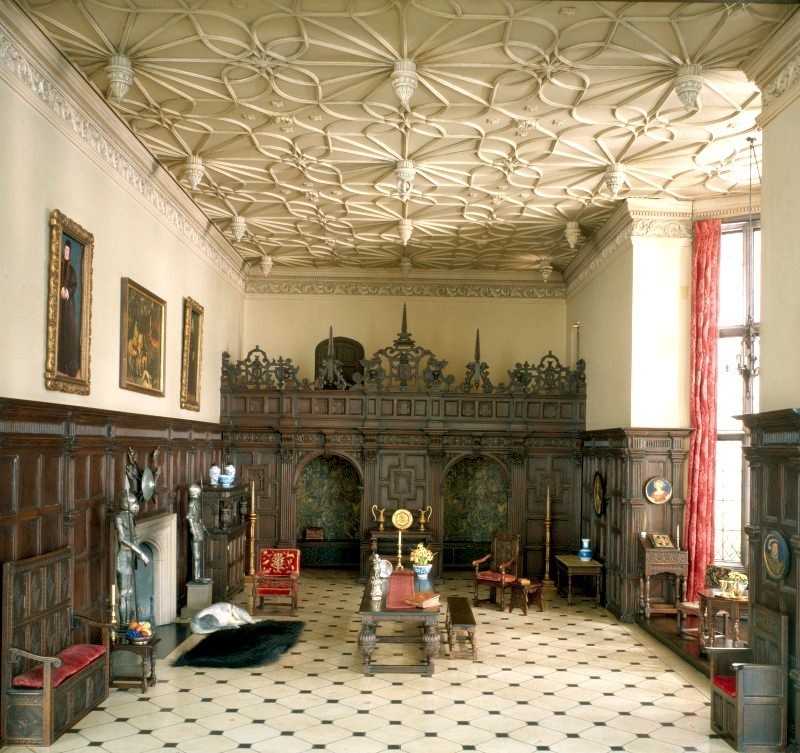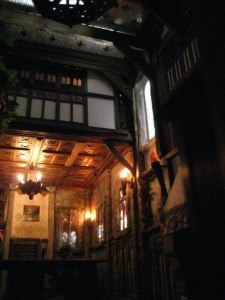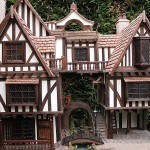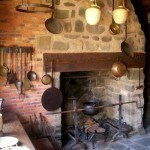Tudor Great Halls
Tudor Great Halls had undergone dramatic change after Henry Tudor ascended the throne as Henry VII in 1485. During medieval times it had been the most important room in the castle, where the Lord received hordes of supporters and where feasts were held for special days. In many castles, all the members of the household sat down to eat at tables set up for every meal.
The Tudor’s brought a period of peace and prosperity to England. The aristocracy no longer had to live in castles, where fortifications were more important than comfortable living conditions. The manor house was born, and over time, the Tudor Great Hall became obsolete.
By the middle of the Tudor era, with Elizabeth I on the throne, the space previously devoted to great halls was put to better use. Large houses had specialized living rooms, such as libraries, drawing rooms, and music rooms. When dining alone, the family might take its meals in a modest room called the parlor.
In The Manor House
The picture above of Mrs. Thorne’s “Tudor Great Hall” room box is what a great hall might look like half-way through the Tudor era. It is one of sixty-eight miniatures designed by Narcissa Niblack Thorne. Most were built in collaboration with Eugene Kupjak, an artisan working with lucite an
gold, who fashioned elements of this miniature after items in a number of famous buildings. The walls in this room box are like those of Parham Castle. The screen across the back is a copy of one found in Wadham College, Oxford. The top of the screen would mask the minstrel’s gallery.
Furniture
Most of the lighter, more graceful looking pieces of furniture are copied from Italian Renaissance originals now in London museums. The settle in the foreground on the left wall is one of the first Tudor designs. More typical of the period is the bulbous-leg table and is viewed by many as the typical Tudor style: over-elaborate, with every available space crowded with detail. When dining at that table, nobles got the stiff high-backed chairs; henchmen sat on the benches.
Accessories
The chandelier in the leaded glass oriel window is a Gothic design, soon to go completely out of style. Candles would be beeswax. The suits of armor are miniature replicas of those worn by soldiers loyal to Henry VIII. The portraits above the picture rail are copies of two Holbeins and one of Mary Queen of Scots, the artist unknown.
Things To Watch Out For
The Tudor era lasted one hundred and fifteen years. In the early period, a manor house great hall had the look of a castle’s: rough stone walls, with tapestries hung in strategic places to block drafts. As the era progressed, dove-cote paneling with linen fold or geometric carvings would do a better job of insulating against the winter wind. Tapestries would still be hung, but their function was to impress the guests with the Lord’s wealth. Gothic decoration would become passé and trend-setting gentry would have none of it.
Beautiful gardens, with paved or gravel walks, replaced the mud around the moat, making it safe to take the fine rugs off the walls, where they had been used as decoration.
A Commoner’s Home
Commoners were not trend-setters. The Tudor Great Halls stayed in fashion long after the Gentry gave them up. Social-climbing middle-class merchants still found it a convenient place to flaunt their riches. Wealthy farmers ignored fashion. They continued the use of the great hall as being the center of family life. It was even used as a dormitory when extended family members and guests visited on festival days
Furniture
While still expensive, furniture became more plentiful as the Tudor era progressed. In a wealthy home it was usually made of oak and was heavy and massive. It was expected to last for generations, passing to the children and grandchildren by will.
Comfortable beds became more and more common in the 16th century and increasing numbers of middle class people slept on feather mattresses rather than straw.
Candles – beeswax when company came to call; tallow (smelly, smokey animal fat) for everyday.
As with other rooms in the home, the social-climbers in the middle class wanted what the gentry had. Guided by the principle “more is better,” they filled their great halls with as much ornamentation as they could afford. Many were rich and could buy the same items as the aristocrats, but not all at the same time, perhaps. In your miniature Tudor project, decide what your 1/12th scale free-holder could afford when decorating the Commoner’s Great Hall.
The Poor
None of the improvements of the 16th century applied to the poor. They continued to live in simple huts with one or two rooms. The house would have been very dark and smoky inside as there was only a small window and smoke escaped through a hole in the thatched roof.
Floors were hard earth and were often covered with rushes to absorb spills from humans and animals. Aromatic plants would be mixed with the rushes, or hung along the walls to counter the odor of too many mammals in close quarters.
Furniture was very basic: benches, stools, a table and wooden chests. Expensive chairs were out of the question.
Windows – the poor still had to make do with strips of linen soaked in linseed oil.
Candles might be tallow, on special occasions, and if they were lucky. Rush candles — a bundle of rushes bound tightly, then dipped in grease – were more common.
Tudor miniature projects can be rewarding, if you do your homework. Think about what a difficult period it was. They were coming out of medieval times and had endured the 30-year War of the Roses, which decimated the economy. A true middle class was developing, which wrenched the social structure out of the feudal past. If you find the the Tudor era fascinating, and authenticity is important to you – do your research!
You may find the Related Posts on Tudor subjects to be helpful.
Susan Downing, with Patrick Owens


